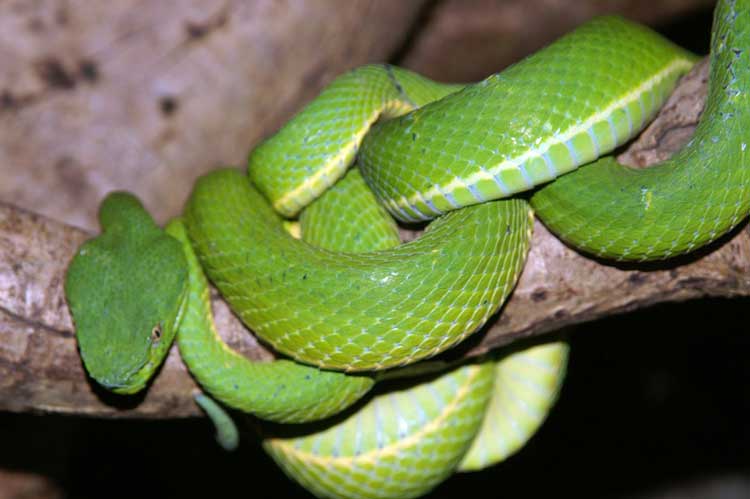
Bothriechis lateralis (*)
Superregnum: Eukaryota
Regnum: Animalia
Subregnum: Eumetazoa
Cladus: Bilateria
Cladus: Nephrozoa
Superphylum: Deuterostomia
Phylum: Chordata
Cladus: Craniata
Subphylum: Vertebrata
Infraphylum: Gnathostomata
Superclassis: Tetrapoda
Cladus: Reptiliomorpha
Cladus: Amniota
Classis: Reptilia
Cladus: Eureptilia
Cladus: Romeriida
Subclassis: Diapsida
Cladus: Sauria
Infraclassis: Lepidosauromorpha
Superordo: Lepidosauria
Ordo: Squamata
Subordo: Serpentes
Infraordo: Caenophidia
Superfamilia: Viperoidea
Familia: Viperidae
Subfamilia: Crotalinae
Genus: Bothriechis
Species : B. lateralis
Common names: side-striped palm pitviper[3] side-striped palm viper,[4] more.
Bothriechis lateralis is a venomous pit viper species found in the mountains of Costa Rica and western Panama.[2] No subspecies are currently recognized.[5]
Description
Adult specimens may exceed 100 centimetres (39 in), but are usually less than 80 centimetres (31 in) in length. These are relatively slender snakes and have a prehensile tail.[3]
B. lateralis
The color pattern consists of an emerald green to bluish green ground color, overlaid with a series of yellow alternating paravertebral vertical bars. Some of the scales adjacent to the yellow in this pattern may be blue or black-tipped. The belly is a uniform yellowing-green, bordered on either side by a pale yellow stripe running along the lower portion of the paraventral scales and the extreme lateral part of the ventral scales. The head is uniformly green on top and a blue or blue-gray postocular stripe may be present. If a postocular stripe is present, it is weakly defined, especially in large adults. The iris is yellow.[3][6]
Juvenile specimens are usually brown with dark brown markings on the head, bronze irises, postocular stripes, paravertebral makings that are edged with yellow, and a tail tip that is yellow or chartreuse. Captive juveniles retain this color pattern for about six months, after which the ground color starts to become a dull lime green and the yellow edges of the paravertebral vertical bars more prominent. It is thought that the shift to adult coloration takes about 18–24 months to complete.[3]
Like many green snakes, captive adults tend to become blue over time, although blue specimens are sometimes found in the wild.[3]
Common names
Side-striped palm-pitviper,[3] side-striped palm viper,[4] green palm viper,[7] yellow-lined palm viper and parrot viper[6]
Geographic range
Found in the mountains of Costa Rica and western Panama, including the Cordillera de Tilarán, the Cordillera Central and the Cordillera de Talamanca to the provinces of Chiriquí Province and Veraguas. Occurs at 850–980 m altitude. The type locality is listed as "Costa Rica vom Vulcan Barbo [Volcán Barba] ... und .. Veragua" [Panama].[2]
Habitat
Occurs in lower montane forest, lower montane wet forest, and lower montane rainforest. Although this species is able to survive is some areas that have been altered for agricultural purposes, such as coffee plantations, it seems they are slowly disappearing from these places. On the other hand, it is common in some protected areas, where populations appear to be doing quite well.[3]
Behavior
This is an arboreal species that spends its time in the thick foliage of forest trees and shrubbery. It is often found at the base of palm fronds. These snakes prefer to remain coiled and still, relying on their camouflage to avoid detection, rather than defending themselves aggressively. However, they will strike quickly if touched.[6]
Feeding
The prehensile tail is not only used as an anchor when resting, but also when it strikes out to grasp its prey, which consists of small birds, rodents, lizards and frogs.[6]
Venom
Bites can be serious, but fatalities are rare.[7] A polyvalent antivenin that covers this species is produced by the Instituto Clodomiro in Costa Rica.[8]
References
Acosta Chaves, V.; Batista, A.; García Rodríguez, A.; Saborío, G.; Vargas Álvarez, J. (2014). "Bothriechis lateralis". IUCN Red List of Threatened Species. 2014: e.T203658A2769431. doi:10.2305/IUCN.UK.2014-1.RLTS.T203658A2769431.en. Retrieved 20 November 2021.
McDiarmid RW, Campbell JA, Touré T. 1999. Snake Species of the World: A Taxonomic and Geographic Reference, vol. 1. Herpetologists' League. 511 pp. ISBN 1-893777-00-6 (series). ISBN 1-893777-01-4 (volume).
Campbell JA, Lamar WW (2004). The Venomous Reptiles of the Western Hemisphere. Ithaca and London: Comstock Publishing Associates. plate 1500. ISBN 0-8014-4141-2.
Bothriechis lateralis Archived January 13, 2008, at the Wayback Machine at Herps of Panama Archived November 1, 2006, at the Wayback Machine. Accessed 27 November 2006.
"Bothriechis lateralis". Integrated Taxonomic Information System. Retrieved 27 November 2006.
Mehrtens JM. 1987. Living Snakes of the World in Color. New York: Sterling Publishers. 480 pp. ISBN 0-8069-6460-X.
Green Palm Viper (Bothriechis lateralis) Archived September 28, 2006, at the Wayback Machine at Cloud Forest Alive Archived 2006-11-18 at the Wayback Machine. Accessed 27 November 2006.
Bothriechis lateralis at Munich AntiVenom INdex. Accessed 27 November 2006.
Retrieved from "http://en.wikipedia.org/"
All text is available under the terms of the GNU Free Documentation License

